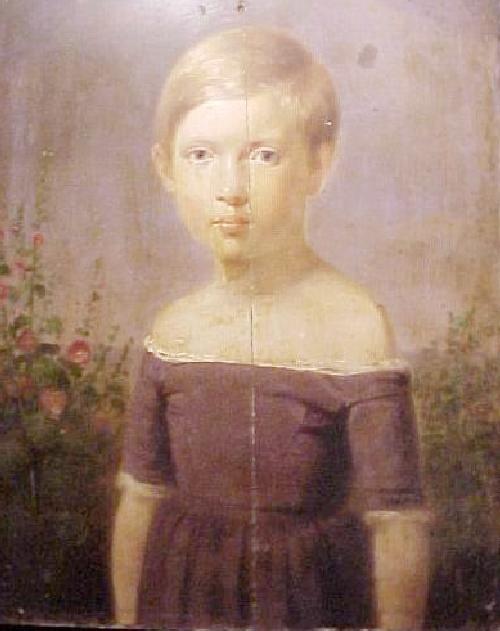
American Folk Art Portrait: 1840s-50s

Figure 1.--This American folk art portrait is unidentified. We believe that the portrait was done in the 1840s or early 50s. While unidentified the child is clearly a boy. He has both short hair and a boyish face. He has not yet been breached. He looks to be about 5-6 years old. He wears a dress with a relatively low neckline.
|
This American folk art portrait is unidentified. We do not know who the boy is or where it was painted. One observer dates it to the 1840-65. We believe the 1840s or early 50s is the most likely date. The dress is a very plain style hich looks to be lavendar or violet. Color dtails are one advantage of theseportraits over photographic portraits. The neckline and sleves are detaild with narrow lace trim. Necklines in childrens dresses were beginning to rise in th 1850s, but we would not rule out theerly 60s completely. While unidentified the child is clearly a boy. He has both short hair and a boyish face. He has not yet been breached. He looks to be about 5-6 years old. He wears a dress with a relatively low neckline. There seem to be no destinctive dress styles for boys. One interesting aspect of the portrait is that even though the boy wears a vry outdated garment, his hair style is very modern. This is a folk art protrait. The pose is very static, but the artist has wonderfully captured the boy's face.
Painting Details
An E-Bay seller provided this description of the portrait, "This is an antique American Folk Art Portrait of what appears to be a boy in a dress. It is an oil painting on a hand champhored walnut board. It is very well executed, however it has sustained a break and has been repaired, as shown below, by regluing the panel and reinforcing the back with brown
packing paper which is glued on. It measures just under 12" high by 9.5" wide. The facial detail is of excellent quality. The painting is unsigned as far as I can tell. It is also rather dirty. The execution is very fine. The painter probably had some academic training. The painting is circa 1840-1865. The edge of the wood is 1/8" thich along the edges and close to 1/4" thick where there is no champhoring. The corners apparently have nail holes and the wood is split slightly on three of the corners, although the wood is still basically intact in those areas. The repaired board seems quite stable. The board curves slightly forward from left to right.
Dresses
Little boys continued to wear dresses like their sisters. We have relatively few precisely dated images. There were not yet any distinctive boy styles. The images we note are show boys wearing esentially the same dresses as thir sisters. We do not know of any contemporary written material on this issue. The images that we have, however, show boys wearing dresses with no distinctive boy styling. Boys wear styles with low necklines as girls did at the time. A good example of this is an unidentified folk art portrait that we believe wss painted in the 1850s. Except for the short hair and boyish face, we would have assumed it ws a girl.
HBU

Navigate the Historic Boys' Clothing Web chronological pages:
[Modern era]
[Chronology]
[The 16th century]
[The 17th Century]
[The early 18th Century]
[The late 18th Century]
[The 1800s]
[The 1810s]
[The 1820s]
[The 1830s]
[The 1840s]
[The 1850s]
[The 1860s]
[The 1870s]
[The 1880s]
Navigate the Boys' Historical Clothing Web Site:
[Return to the Main U.S. 1850s chronology page]
[Introduction]
[Activities]
[Biographies]
[Chronology]
[Clothing styles]
[Countries]
[Bibliographies]
[Contributions]
[FAQs]
[Glossary]
[Satellite sites]
[Tools]
[Boys' Clothing Home]
Created: February 10, 2003
Last updated: February 10, 2003



